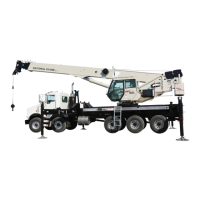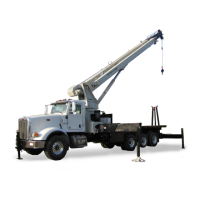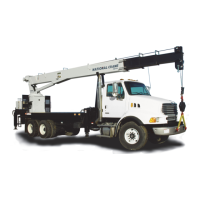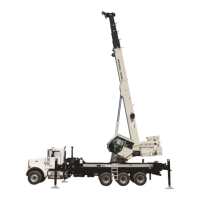SAFETY PRECAUTIONS - CRANE NBT40-1 SERIES OPERATOR MANUAL
2-6
3-29-2018 Control # 610-00
The operator must select the proper Load Chart/Reach
Diagram and Rated Capacity Limiter (RCL) System program
for the outrigger position selected.
Before swinging the superstructure over the side when the
outriggers are retracted, check the Load Chart/Reach
Diagram for backwards stability.
Long cantilever booms can create a tipping condition when
in an extended and lowered position. Retract the boom
proportionally with reference to the capacity of the applicable
Load Chart/Reach Diagram.
Check equipment stability before lifting loads. Ensure the
outriggers are firmly positioned on solid surfaces. Ensure the
equipment is level, brakes are set, and the load is properly
rigged and attached to the hook. Check the Load Chart
against the weight of the load. Lift the load slightly off the
ground and recheck the stability before proceeding with the
lift. Determine the weight of the load before you attempt the
lift.
Outrigger beams and jack cylinders (plus center front
stabilizer, if equipped) must be properly extended and set to
provide precise leveling of the equipment. Tires must be
clear of the ground before lifting on outriggers.KEEP THE
BOOM SHORT. Swinging loads with a long line can create
an unstable condition and possible structural failure of the
boom.
Load Charts
Load Charts represent the absolute maximum allowable
loads, which are based on either tipping or structural
limitations of the equipment under specific conditions.
Knowing the precise load radius, boom length, and boom
angle should be a part of your routine planning and
operation. Actual loads, including necessary allowances,
should be kept below the capacity shown on the applicable
Load Chart.
Load Chart capacities are based on freely suspended loads.
You must use the appropriate Load Chart when determining
the capability of the equipment in the configuration required
to perform the lift.
Maximum lifting capacity is available at the shortest radius,
minimum boom length, and highest boom angle.
Do not remove the Load Charts from the equipment.
Work Site
Prior to any operation, you must inspect the entire work site,
including ground conditions, where the equipment will travel
and operate. Be sure that the surfaces will support a load
greater than the equipment’s weight and maximum capacity.
Be aware of all conditions that could adversely effect the
stability of the equipment.
WIND FORCES
There are basic principles that must be followed while
operating in windy conditions. This information has been
provided to assist in determining safe operation in windy
conditions.
Always use extreme caution when windy conditions exist.
NEVER exceed the rated capacity shown on the Load Chart.
Always check the Load Chart to ensure the load to be
lifted is within the rated capacity of the crane.
Wind can have a significant effect on loads that may be lifted
by a crane. Wind forces act differently on a crane depending
upon the direction from which the wind is blowing (e.g., wind
on the rear of the boom can result in decreased forward
stability, wind on the underside of the boom can result in
decreased backward stability, wind on the side of the boom
can result in structural damages, etc.)
Wind forces can exert extreme dynamic loads. National
Crane recommends that a lift not be made if the wind can
cause a loss of control in handling the load.
Wind forces can be determined by typical visible effects on
the landscape.To assist you in determining prevailing wind
conditions, refer to Table 2-1.
NOTE: The wind speed corresponding to the Beaufort
scale in the table is mean wind speed at 10 m
(33 ft) elevation over a period of 10 minutes.
Table 2-1 Beaufort Wind Scale
Maximum Wind Speed
Beaufort
Number
Description m/s km/h mph
Visible Indicator
Effects of wind as observed on land
Zero (0) Calm 0.3 1.1 0.7 Calm; smoke rises vertically
1 Light Air 1.5 5.4 3.4
Smoke drift indicates wind direction. Leaves and wind vanes
are stationary.
2 Light Breeze 3.3 11.9 7.4
Wind felt on exposed skin. Leaves rustle. Wind vanes begin to
move.

